Spatiotemporal Evolution and Driving Factors of Urban Resilience Against Disasters: A Dual Perspective of Urban Systems and Resilience Capacities
Abstract
:1. Introduction
- It defines resilience from the “bouncing forward” perspective and identifies corresponding resilience capacities at each stage of the disaster management.
- Unlike predominantly one-dimensional frameworks for urban resilience, this study integrates urban systems (economic, social, infrastructure, and environmental subsystems) with multiple resilience capacities (preparedness, absorptive, recovery, and transformative) to construct a two-dimensional evaluation framework. This approach enhances both the scientific rigor and effectiveness of resilience assessments and our understanding of urban resilience.
- Based on an analysis of spatial and temporal differentiation in resilience, the study employs the spatial Markov chain method to reveal the dynamic evolution of resilience patterns.
- It applies the geographic detector technique to identify key factors of resilience and proposes driving mechanisms, offering policy recommendations to enhance urban resilience.
2. Theoretical Framework
- Recovery capacity: After the disaster, urban systems show the ability to recover either to their original state or a new equilibrium [29].
- Transformative capacity: Reflecting the concept of “bouncing forward”, this capacity targets long-term disaster mitigation by emphasizing learning, innovation, and reorganization [63]. It enables urban systems to move beyond simple adaptation, proactively preventing more severe disasters in the future.
3. Materials and Methods
3.1. Study Area
3.2. Data Resource
3.3. Methodology
3.3.1. Establishment of Evaluation Indicator System of Urban Resilience
- (1)
- Initial evaluation indicator system
- (2)
- Screening of the indicator system
3.3.2. Construction of Urban Resilience Evaluation Model Based on the Improved CRITIC-TOPSIS Method
- (1)
- Weight calculation based on the improved CRITIC method
- (2)
- Resilience index calculation based on the TOPSIS method
- (3)
- Sensitivity analysis
3.3.3. Spatiotemporal Evolution Analysis of Urban Resilience
- (1)
- Kernel density estimation
- (2)
- Global spatial autocorrelation
- (3)
- Spatial Markov Chain model
3.3.4. Detection of Influencing Factors of Urban Resilience Based on Geo-Detector
4. Results and Analysis
4.1. Urban Resilience Evaluation Index Results and Sensitivity Analysis
4.2. Spatiotemporal Evolution Results of Urban Resilience in the Chengdu–Chongqing Urban Agglomeration
4.2.1. Temporal Evolution Analysis of Resilience
- (1)
- Comprehensive resilience levels
- (2)
- Resilience levels across dimensions
- (3)
- Kernel density estimation of comprehensive resilience
4.2.2. Spatiotemporal Evolution Characteristics of Resilience Distribution
- (1)
- Distribution of comprehensive resilience
- (2)
- Distribution of urban subsystem resilience index
- (3)
- Distribution of resilience capacity index
4.2.3. Global Spatial Autocorrelation Analysis
4.2.4. Analysis of the Dynamic Transition Characteristics of Resilience in the Chengdu–Chongqing Urban Agglomeration
4.3. Detection of Influencing Factors of Urban Resilience
- In 2010, the primary driving factors included urban infrastructure investment (IN7), technological investment (EC7), medical insurance coverage (SC1), drainage pipeline density (IN1), and communication technology capacity (IN2). This indicates that resilience improvement primarily relied on the development of physical infrastructure, aligning with the fundamental requirement of disaster resistance during the early urbanization phase.
- By 2014, as economic and social development progressed, the driving factors gradually shifted towards economic structure optimization and the enhancement of public service capacity. The proportion of the tertiary industry (EC5) and public transportation availability (IN6) emerged as the primary driving factors, underscoring the importance of economic diversification and robust public service systems for strengthening urban resilience.
- By 2018, the driving factors became further diversified. The prominent role of food security (EC3) reflected the city’s foundational capacity to ensure basic living standards during disasters, while the significant influence of economic tolerance (EC1) underscored the growing importance of economic resilience and adaptive capacity in the face of disasters. Additionally, improvements in social security and employment support (SC5) also emerged as crucial for enhancing social resilience. Overall, resilience-building expanded beyond physical infrastructure to encompass resource security and social stability.
- In 2022, infrastructure and technological innovation continued to play a critical role, with soft power factors such as educational and cultural levels (SC6) ranking among the top driving factors. This marks a high-quality transformation in the mechanism’s driving resilience.
5. Discussion
5.1. In-Depth Understanding of the Spatiotemporal Patterns and Underlying Mechanisms of Urban Resilience
5.2. Spillover Effect of Urban Resilience
6. Conclusions
Supplementary Materials
Author Contributions
Funding
Data Availability Statement
Conflicts of Interest
References
- United Nations Office for Disarmament Affairs. Human Cost of Disasters: An Overview of the Last 20 Years 2000–2019; United Nations: New York, NY, USA, 2020; ISBN 978-92-1-005447-8. [Google Scholar]
- Thomas, V.; Albert, J.R.G.; Hepburn, C. Contributors to the Frequency of Intense Climate Disasters in Asia-Pacific Countries. Clim. Chang. 2014, 126, 381–398. [Google Scholar] [CrossRef]
- Coronese, M.; Lamperti, F.; Keller, K.; Chiaromonte, F.; Roventini, A. Evidence for Sharp Increase in the Economic Damages of Extreme Natural Disasters. Proc. Natl. Acad. Sci. USA 2019, 116, 21450–21455. [Google Scholar] [CrossRef] [PubMed]
- Li, X.; Wang, Y.; Song, Y. Unraveling Land System Vulnerability to Rapid Urbanization: An Indicator-Based Vulnerability Assessment for Wuhan, China. Environ. Res. 2022, 211, 112981. [Google Scholar] [CrossRef] [PubMed]
- Mortoja, M.G.; Yigitcanlar, T. How Does Peri-Urbanization Trigger Climate Change Vulnerabilities? An Investigation of the Dhaka Megacity in Bangladesh. Remote Sens. 2020, 12, 3938. [Google Scholar] [CrossRef]
- Liang, L.; Chen, M.; Lu, D. Revisiting the Relationship Between Urbanization and Economic Development in China Since the Reform and Opening-Up. Chin. Geogr. Sci. 2022, 32, 1–15. [Google Scholar] [CrossRef]
- Agarwal, P.; Sahoo, D.; Parida, Y.; Ranjan Paltasingh, K.; Roy Chowdhury, J. Land Use Changes and Natural Disaster Fatalities: Empirical Analysis for India. Ecol. Indic. 2023, 154, 110525. [Google Scholar] [CrossRef]
- Cui, Y.; Cheng, D.; Choi, C.E.; Jin, W.; Lei, Y.; Kargel, J.S. The Cost of Rapid and Haphazard Urbanization: Lessons Learned from the Freetown Landslide Disaster. Landslides 2019, 16, 1167–1176. [Google Scholar] [CrossRef]
- Poudel, D.P.; Blackburn, S.; Manandhar, R.; Adhikari, B.; Ensor, J.; Shrestha, A.; Timsina, N.P. The Urban Political Ecology of ‘Haphazard Urbanisation’ and Disaster Risk Creation in the Kathmandu Valley, Nepal. Int. J. Disaster Risk Reduct. 2023, 96, 103924. [Google Scholar] [CrossRef]
- Dormady, N.; Roa-Henriquez, A.; Rose, A. Economic Resilience of the Firm: A Production Theory Approach. Int. J. Prod. Econ. 2019, 208, 446–460. [Google Scholar]
- Duan, W.; Madasi, J.D.; Khurshid, A.; Ma, D. Industrial Structure Conditions Economic Resilience. Technol. Forecast. Soc. Chang. 2022, 183, 121944. [Google Scholar] [CrossRef]
- Mavhura, E.; Manyangadze, T.; Aryal, K.R. A Composite Inherent Resilience Index for Zimbabwe: An Adaptation of the Disaster Resilience of Place Model. Int. J. Disaster Risk Reduct. 2021, 57, 102152. [Google Scholar] [CrossRef]
- Clark-Ginsberg, A.; McCaul, B.; Bremaud, I.; Cáceres, G.; Mpanje, D.; Patel, S.; Patel, R. Practitioner Approaches to Measuring Community Resilience: The Analysis of the Resilience of Communities to Disasters Toolkit. Int. J. Disaster Risk Reduct. 2020, 50, 101714. [Google Scholar] [CrossRef]
- Yamazaki-Honda, R. Promoting Coherence Among Disaster Risk Reduction, Climate Change Adaptation, and Sustainable Development for Disaster Resilience. J. Disaster Res. 2022, 17, 1015–1021. [Google Scholar]
- Liu, Y.; Li, Q.; Li, W.; Jia, L.; Pei, X. Knowledge Map and Hotspot Analysis in Climate Resilience Infrastructure (CRI) from 1997 to 2022 through Scientometric Analysis. Environ. Res. 2023, 228, 115874. [Google Scholar] [PubMed]
- Cheng, T.; Zhao, Y.; Song, Y.; Ma, L.; Zhang, Z.; Luo, P.; Gao, P.; Zhang, M.; Zhao, C. Towards Resilience Effectiveness: Assessing Its Patterns and Determinants to Identify Optimal Geographic Zones. J. Clean. Prod. 2023, 429, 139596. [Google Scholar] [CrossRef]
- Shreve, C.M.; Kelman, I. Does Mitigation Save? Reviewing Cost-Benefit Analyses of Disaster Risk Reduction. Int. J. Disaster Risk Reduct. 2014, 10, 213–235. [Google Scholar] [CrossRef]
- Wang, H.; Gao, X.; Xu, T.; Xue, H.; He, W. Spatial-Temporal Evolution Mechanism and Efficiency Evaluation of Drought Resilience System in China. J. Clean. Prod. 2023, 428, 139298. [Google Scholar] [CrossRef]
- Hu, L.; Meng, J.; Xiong, C.; Fang, W.; Yang, J.; Liu, M.; Bi, J.; Ma, Z. City-Level Resilience to Extreme Weather Shocks Revealed by Satellite Nighttime Lights in China. Sustain. Cities Soc. 2024, 101, 105167. [Google Scholar] [CrossRef]
- Sebestyén, V.; Trájer, A.J.; Domokos, E.; Torma, A.; Abonyi, J. Objective Well-Being Level (OWL) Composite Indicator for Sustainable and Resilient Cities. Ecol. Indic. 2024, 158, 111460. [Google Scholar] [CrossRef]
- Aguilar-Barajas, I.; Sisto, N.P.; Ramirez, A.I.; Magaña-Rueda, V. Building Urban Resilience and Knowledge Co-Production in the Face of Weather Hazards: Flash Floods in the Monterrey Metropolitan Area (Mexico). Environ. Sci. Policy 2019, 99, 37–47. [Google Scholar] [CrossRef]
- Davidson, K.; Nguyen, T.M.P.; Beilin, R.; Briggs, J. The Emerging Addition of Resilience as a Component of Sustainability in Urban Policy. Cities 2019, 92, 1–9. [Google Scholar] [CrossRef]
- Fang, Y.; Zhu, F.; Qiu, X.; Zhao, S. Effects of Natural Disasters on Livelihood Resilience of Rural Residents in Sichuan. Habitat Int. 2018, 76, 19–28. [Google Scholar] [CrossRef]
- Feng, X.; Xiu, C.; Bai, L.; Zhong, Y.; Wei, Y. Comprehensive Evaluation of Urban Resilience Based on the Perspective of Landscape Pattern: A Case Study of Shenyang City. Cities 2020, 104, 102722. [Google Scholar] [CrossRef]
- Chen, X.; Guo, Z.; Zhou, H.; Qian, X.; Zhang, X. Urban Flood Resilience Assessment Based on VIKOR-GRA: A Case Study in Chongqing, China. KSCE J. Civ. Eng. 2022, 26, 4178–4194. [Google Scholar] [CrossRef]
- Shi, Y.; Zhai, G.; Xu, L.; Zhou, S.; Lu, Y.; Liu, H.; Huang, W. Assessment Methods of Urban System Resilience: From the Perspective of Complex Adaptive System Theory. Cities 2021, 112, 103141. [Google Scholar] [CrossRef]
- Harrison, C.G.; Williams, P.R. A Systems Approach to Natural Disaster Resilience. Simul. Model. Pract. Theory 2016, 65, 11–31. [Google Scholar] [CrossRef] [PubMed]
- Kusumastuti, R.D.; Viverita; Husodo, Z.A.; Suardi, L.; Danarsari, D.N. Developing a Resilience Index towards Natural Disasters in Indonesia. Int. J. Disaster Risk Reduct. 2014, 10, 327–340. [Google Scholar] [CrossRef]
- Chen, C.; Xu, L.; Zhao, D.; Xu, T.; Lei, P. A New Model for Describing the Urban Resilience Considering Adaptability, Resistance and Recovery. Saf. Sci. 2020, 128, 104756. [Google Scholar] [CrossRef]
- Datola, G. Implementing Urban Resilience in Urban Planning: A Comprehensive Framework for Urban Resilience Evaluation. Sustain. Cities Soc. 2023, 98, 104821. [Google Scholar] [CrossRef]
- Ouyang, M.; Dueñas-Osorio, L.; Min, X. A Three-Stage Resilience Analysis Framework for Urban Infrastructure Systems. Struct. Saf. 2012, 36–37, 23–31. [Google Scholar] [CrossRef]
- Zhang, X.; Song, J.; Peng, J.; Wu, J. Landslides-Oriented Urban Disaster Resilience Assessment—A Case Study in ShenZhen, China. Sci. Total Environ. 2019, 661, 95–106. [Google Scholar] [CrossRef] [PubMed]
- Graveline, M.-H.; Germain, D. Disaster Risk Resilience: Conceptual Evolution, Key Issues, and Opportunities. Int. J. Disaster Risk Sci. 2022, 13, 330–341. [Google Scholar] [CrossRef]
- Rus, K.; Kilar, V.; Koren, D. Resilience Assessment of Complex Urban Systems to Natural Disasters: A New Literature Review. Int. J. Disaster Risk Reduct. 2018, 31, 311–330. [Google Scholar] [CrossRef]
- Desouza, K.C.; Flanery, T.H. Designing, Planning, and Managing Resilient Cities: A Conceptual Framework. Cities 2013, 35, 89–99. [Google Scholar] [CrossRef]
- Alexander, D.E. Resilience and Disaster Risk Reduction: An Etymological Journey. Nat. Hazards Earth Syst. Sci. 2013, 13, 2707–2716. [Google Scholar] [CrossRef]
- Amarakoon, P.M.; Gundersen, R.B.; Muhire, A.; Utvik, V.A.; Braa, J. Exploring Health Information System Resilience during COVID-19 Pandemic: Case Studies from Norway, Sri Lanka & Rwanda. BMC Health Serv. Res. 2023, 23, 1433. [Google Scholar] [CrossRef]
- Chelleri, L.; Baravikova, A. Understandings of Urban Resilience Meanings and Principles across Europe. Cities 2021, 108, 102985. [Google Scholar] [CrossRef]
- Rubim, I.C.; Borges, M.R. The Resilience and Its Dimensions. In Proceedings of the ISCRAM, Albi, France, 21–24 May 2017. [Google Scholar]
- Zhao, R.; Fang, C.; Liu, J.; Zhang, L. The Evaluation and Obstacle Analysis of Urban Resilience from the Multidimensional Perspective in Chinese Cities. Sustain. Cities Soc. 2022, 86, 104160. [Google Scholar]
- Brugmann, J. Financing the Resilient City. Environ. Urban. 2012, 24, 215–232. [Google Scholar]
- Meerow, S.; Newell, J.P.; Stults, M. Defining Urban Resilience: A Review. Landsc. Urban Plan. 2016, 147, 38–49. [Google Scholar] [CrossRef]
- Grainger-Brown, J.; Malekpour, S.; Raven, R.; Taylor, E. Exploring Urban Transformation to Inform the Implementation of the Sustainable Development Goals. Cities 2022, 131, 103928. [Google Scholar] [CrossRef]
- Mou, Y.; Luo, Y.; Su, Z.; Wang, J.; Liu, T. Evaluating the Dynamic Sustainability and Resilience of a Hybrid Urban System: Case of Chengdu, China. J. Clean. Prod. 2021, 291, 125719. [Google Scholar] [CrossRef]
- Ribeiro, P.J.G.; Pena Jardim Gonçalves, L.A. Urban Resilience: A Conceptual Framework. Sustain. Cities Soc. 2019, 50, 101625. [Google Scholar] [CrossRef]
- Alliance, R. Urban Resilience Research Prospectus. In A Resilience Alliance Initiative for Transitioning Urban Systems Towards Sustainable Futures; Australian CSIRO Arizona State University: Canberra, Australia, 2007. [Google Scholar]
- Mendizabal, M.; Heidrich, O.; Feliu, E.; García-Blanco, G.; Mendizabal, A. Stimulating Urban Transition and Transformation to Achieve Sustainable and Resilient Cities. Renew. Sustain. Energy Rev. 2018, 94, 410–418. [Google Scholar] [CrossRef]
- Godschalk, D.R. Urban Hazard Mitigation: Creating Resilient Cities. Nat. Hazards Rev. 2003, 4, 136–143. [Google Scholar] [CrossRef]
- Almeida, M.D.; Telhado, M.J.; Morais, M.; Barreiro, J.; Lopes, R. Urban Resilience to Flooding: Triangulation of Methods for Hazard Identification in Urban Areas. Sustainability 2020, 12, 2227. [Google Scholar] [CrossRef]
- Balsas, C.J. Downtown Resilience: A Review of Recent (Re) Developments in Tempe, Arizona. Cities 2014, 36, 158–169. [Google Scholar] [CrossRef]
- Sendai Framework Terminology on Disaster Risk Reduction|UNDRR. Available online: https://www.undrr.org/drr-glossary/terminology (accessed on 7 January 2025).
- Cheng, Y.; Liu, J. Evaluation of Urban Resilience in the Post-COVID-19 Period: A Case Study of the Yangtze Delta City Group in China. Int. J. Disaster Risk Reduct. 2023, 97, 104028. [Google Scholar] [CrossRef]
- Sarker, M.N.I.; Peng, Y.; Yiran, C.; Shouse, R.C. Disaster Resilience through Big Data: Way to Environmental Sustainability. Int. J. Disaster Risk Reduct. 2020, 51, 101769. [Google Scholar] [CrossRef]
- Gaisie, E.; Han, S.S.; Kim, H.M. Complexity of Resilience Capacities: Household Capitals and Resilience Outcomes on Ements the Disaster Cycle in Informal Settl. Int. J. Disaster Risk Reduct. 2021, 60, 102292. [Google Scholar] [CrossRef]
- Li, G.; Kou, C.; Wang, Y.; Yang, H. System Dynamics Modelling for Improving Urban Resilience in Beijing, China. Resour. Conserv. Recycl. 2020, 161, 104954. [Google Scholar] [CrossRef]
- Kapucu, N.; Ge, Y.; Rott, E.; Isgandar, H. Urban Resilience: Multidimensional Perspectives, Challenges and Prospects for Future Research. Urban Gov. 2024, 4, 162–179. [Google Scholar] [CrossRef]
- Sajjad, M.; Chan, J.C.L.; Chopra, S.S. Rethinking Disaster Resilience in High-Density Cities: Towards an Urban Resilience Knowledge System. Sustain. Cities Soc. 2021, 69, 102850. [Google Scholar] [CrossRef]
- Datola, G.; Bottero, M.; De Angelis, E.; Romagnoli, F. Operationalising Resilience: A Methodological Framework for Assessing Urban Resilience through System Dynamics Model. Ecol. Model. 2022, 465, 109851. [Google Scholar]
- Zaman, F. The Role of Popular Discourse about Climate Change in Disaster Preparedness: A Critical Discourse Analysis. Int. J. Disaster Risk Reduct. 2021, 60, 102270. [Google Scholar] [CrossRef]
- Spialek, M.L.; Branton, S.E. From Recovery to Preparedness: An Examination of Resources, Individual Disaster Communication, and Anticipatory Resilience Capacity during the 2023 U.S. Tornado Season. J. Appl. Commun. Res. 2024, 52, 682–701. [Google Scholar] [CrossRef]
- Zeng, X.; Yu, Y.; Yang, S.; Lv, Y.; Sarker, M.N.I. Urban Resilience for Urban Sustainability: Concepts, Dimensions, and Perspectives. Sustainability 2022, 14, 2481. [Google Scholar] [CrossRef]
- Masik, G.; Gajewski, R. Working towards Urban Capacity and Resilience Strategy Implementation: Adaptation Plans and Strategies in Polish Cities. Cities 2021, 119, 103381. [Google Scholar]
- Maurischa, S.D.; Fahmi, F.Z.; Suroso, D.S.A. Transformative Resilience: Transformation, Resilience and Capacity of Coastal Communities in Facing Disasters in Two Indonesian Villages. Int. J. Disaster Risk Reduct. 2023, 88, 103615. [Google Scholar] [CrossRef]
- The National Development and Reform Commission and the Ministry of Housing and Construction Jointly Issued the Chengdu-Chongqing City Cluster Development Plan. Sichuan People’s Government Website. Available online: https://www.sc.gov.cn/10462/10464/10797/2016/5/5/10378968.shtml?cid=303 (accessed on 22 March 2025).
- Wan, J.; Li, Y.; Ma, C.; Jiang, T.; Su, Y.; Zhang, L.; Song, X.; Sun, H.; Wang, Z.; Zhao, Y. Measurement of Coupling Coordination Degree and Spatio-Temporal Characteristics of the Social Economy and Ecological Environment in the Chengdu–Chongqing Urban Agglomeration under High-Quality Development. Int. J. Environ. Res. Public. Health 2021, 18, 11629. [Google Scholar]
- Zhang, X.; Lu, W. Impact of County Industrial Agglomeration on High-Quality Economic Development in Shuangcheng Economic Circle in Chengdu-Chongqing Area: A Perspective of Spatial Spillover Effect. Resour. Environ. Yangtze Basin 2024, 33, 2127–2139. [Google Scholar]
- Xu, J.; Wang, J.; Liu, H. Study on the feasibility and implementation path of the coordinated development of foreign trade in Chengdu-Chongqing Double-city Economic Circle. J. Chongqing Univ. (Soc. Sci. Ed.), 2025; in press. [Google Scholar]
- Feng, X. Research on the Coupling and Coordinated Development of Transportation and Regional Economy in Chengdu–Chongqing Area. Railw. Transp. Ecomomy 2022, 44, 92–98. [Google Scholar] [CrossRef]
- Amarasinghe, U.; Samad, M.; Anputhas, M. Spatial Clustering of Rural Poverty and Food Insecurity in Sri Lanka. Food Policy 2005, 30, 493–509. [Google Scholar] [CrossRef]
- Dai, X.-G.; Liu, Y.; Wang, P. Warm–Dry Collocation of Recent Drought in Southwestern China Tied to Moisture Transport and Climate Warming. Chin. Phys. B 2015, 24, 049201. [Google Scholar]
- Fleisher, B.; Li, H.; Zhao, M.Q. Human Capital, Economic Growth, and Regional Inequality in China. J. Dev. Econ. 2010, 92, 215–231. [Google Scholar]
- Zhu, S.; Li, D.; Huang, G.; Chhipi-Shrestha, G.; Nahiduzzaman, K.M.; Hewage, K.; Sadiq, R. Enhancing Urban Flood Resilience: A Holistic Framework Incorporating Historic Worst Flood to Yangtze River Delta, China. Int. J. Disaster Risk Reduct. 2021, 61, 102355. [Google Scholar] [CrossRef]
- Lu, H.; Lu, X.; Jiao, L.; Zhang, Y. Evaluating Urban Agglomeration Resilience to Disaster in the Yangtze Delta City Group in China. Sustain. Cities Soc. 2022, 76, 103464. [Google Scholar] [CrossRef]
- Zhu, S.; Li, D.; Feng, H.; Zhang, N. The Influencing Factors and Mechanisms for Urban Flood Resilience in China: From the Perspective of Social-Economic-Natural Complex Ecosystem. Ecol. Indic. 2023, 147, 109959. [Google Scholar] [CrossRef]
- Yang, M.; Wang, J.; Jing, Z.; Liu, B.; Niu, H. Evaluation and Regulation of Resource-Based City Resilience: Evidence from Shanxi Province, China. Int. J. Disaster Risk Reduct. 2022, 81, 103256. [Google Scholar] [CrossRef]
- Ji, J.; Wang, D. Evaluation Analysis and Strategy Selection in Urban Flood Resilience Based on EWM-TOPSIS Method and Graph Model. J. Clean. Prod. 2023, 425, 138955. [Google Scholar] [CrossRef]
- Li, Y.; Li, Y.; Kappas, M.; Pavao-Zuckerman, M. Identifying the Key Catastrophic Variables of Urban Social-Environmental Resilience and Early Warning Signal. Environ. Int. 2018, 113, 184–190. [Google Scholar] [CrossRef] [PubMed]
- Liu, D.; Wang, C.; Ji, Y.; Fu, Q.; Li, M.; Ali, S.; Li, T.; Cui, S. Measurement and Analysis of Regional Flood Disaster Resilience Based on a Support Vector Regression Model Refined by the Selfish Herd Optimizer with Elite Opposition-Based Learning. J. Environ. Manag. 2021, 300, 113764. [Google Scholar] [CrossRef]
- Fu, H.; Hong, N.; Liao, C. Spatio-Temporal Patterns of Chinese Urban Recovery and System Resilience under the Pandemic New Normal. Cities 2023, 140, 104385. [Google Scholar] [CrossRef]
- McCartney, G.; Pinto, J.; Liu, M. City Resilience and Recovery from COVID-19: The Case of Macao. Cities 2021, 112, 103130. [Google Scholar] [PubMed]
- Sun, R.; Shi, S.; Reheman, Y.; Li, S. Measurement of Urban Flood Resilience Using a Quantitative Model Based on the Correlation of Vulnerability and Resilience. Int. J. Disaster Risk Reduct. 2022, 82, 103344. [Google Scholar] [CrossRef]
- Li, Z.; Fu, D.; Wang, J.; Min, K.; Zhang, J. Urban Resilience Assessment Model for Waterlogging Disasters and Its Application. J. Tsinghua Univ. Sci. Technol. 2022, 62, 266–276. [Google Scholar]
- Sajjad, M. Disaster Resilience in Pakistan: A Comprehensive Multi-Dimensional Spatial Profiling. Appl. Geogr. 2021, 126, 102367. [Google Scholar] [CrossRef]
- Kotzee, I.; Reyers, B. Piloting a Social-Ecological Index for Measuring Flood Resilience: A Composite Index Approach. Ecol. Indic. 2016, 60, 45–53. [Google Scholar]
- Ling, T.-Y.; Chiang, Y.-C. Strengthening the Resilience of Urban Retailers towards Flood Risks-A Case Study in the Riverbank Region of Kaohsiung City. Int. J. Disaster Risk Reduct. 2018, 27, 541–555. [Google Scholar] [CrossRef]
- Burbules, N.C.; Fan, G.; Repp, P. Five Trends of Education and Technology in a Sustainable Future. Geogr. Sustain. 2020, 1, 93–97. [Google Scholar]
- Cutter, S.L.; Barnes, L.; Berry, M.; Burton, C.; Evans, E.; Tate, E.; Webb, J. A Place-Based Model for Understanding Community Resilience to Natural Disasters. Glob. Environ. Chang. 2008, 18, 598–606. [Google Scholar] [CrossRef]
- Forrest, S.A.; Trell, E.-M.; Woltjer, J. Socio-Spatial Inequalities in Flood Resilience: Rainfall Flooding in the City of Arnhem. Cities 2020, 105, 102843. [Google Scholar] [CrossRef]
- Cao, F.; Xu, X.; Zhang, C.; Kong, W. Evaluation of Urban Flood Resilience and Its Space-Time Evolution: A Case Study of Zhejiang Province, China. Ecol. Indic. 2023, 154, 110643. [Google Scholar] [CrossRef]
- Zhang, H.; Yang, J.; Li, L.; Shen, D.; Wei, G.; Dong, S. Measuring the Resilience to Floods: A Comparative Analysis of Key Flood Control Cities in China. Int. J. Disaster Risk Reduct. 2021, 59, 102248. [Google Scholar] [CrossRef]
- Cutter, S.L.; Ash, K.D.; Emrich, C.T. The Geographies of Community Disaster Resilience. Glob. Environ. Chang. 2014, 29, 65–77. [Google Scholar] [CrossRef]
- Tian, C.; Fang, Y.; Yang, L.E.; Zhang, C. Spatial-Temporal Analysis of Community Resilience to Multi-Hazards in the Anning River Basin, Southwest China. Int. J. Disaster Risk Reduct. 2019, 39, 101144. [Google Scholar] [CrossRef]
- AbouKorin, S.A.A.; Han, H.; Mahran, M.G.N. Role of Urban Planning Characteristics in Forming Pandemic Resilient Cities–Case Study of COVID-19 Impacts on European Cities within England, Germany and Italy. Cities 2021, 118, 103324. [Google Scholar] [CrossRef]
- Yang, Y.; Guo, H.; Wang, D.; Ke, X.; Li, S.; Huang, S. Flood Vulnerability and Resilience Assessment in China Based on Super-Efficiency DEA and SBM-DEA Methods. J. Hydrol. 2021, 600, 126470. [Google Scholar] [CrossRef]
- Ruan, J.; Chen, Y.; Yang, Z. Assessment of Temporal and Spatial Progress of Urban Resilience in Guangzhou under Rainstorm Scenarios. Int. J. Disaster Risk Reduct. 2021, 66, 102578. [Google Scholar] [CrossRef]
- Ji, J.; Fang, L.; Chen, J.; Ding, T. A Novel Framework for Urban Flood Resilience Assessment at the Urban Agglomeration Scale. Int. J. Disaster Risk Reduct. 2024, 108, 104519. [Google Scholar] [CrossRef]
- Cheng, T.; Zhao, Y.; Zhao, C. Exploring the Spatio-Temporal Evolution of Economic Resilience in Chinese Cities during the COVID-19 Crisis. Sustain. Cities Soc. 2022, 84, 103997. [Google Scholar] [CrossRef]
- Dhar, T.; Bornstein, L.; Lizarralde, G.; Nazimuddin, S.M. Risk Perception—A Lens for Understanding Adaptive Behaviour in the Age of Climate Change? Narratives from the Global South. Int. J. Disaster Risk Reduct. 2023, 95, 103886. [Google Scholar] [CrossRef]
- Wang, C.; Wu, J.; Buren, J.; Guo, E.; Liang, H. Modeling the Inter-Regional Economic Consequences of Sequential Typhoon Disasters in China. J. Clean. Prod. 2021, 298, 126740. [Google Scholar] [CrossRef]
- Ye, X.; Du, J.; Han, Y.; Newman, G.; Retchless, D.; Zou, L.; Ham, Y.; Cai, Z. Developing Human-Centered Urban Digital Twins for Community Infrastructure Resilience: A Research Agenda. J. Plan. Lit. 2023, 38, 187–199. [Google Scholar] [CrossRef]
- Gim, J.; Shin, S. Disaster Vulnerability and Community Resilience Factors Affecting Post-Disaster Wellness: A Longitudinal Analysis of the Survey on the Change of Life of Disaster Victim. Int. J. Disaster Risk Reduct. 2022, 81, 103273. [Google Scholar] [CrossRef]
- Urbina L, O.J.; Fekete, A.; Matos, J.C.; Teixeira, E.R. Social Resilience Assessment for Urban Fires in Guimarães Historic Center. Int. J. Disaster Risk Reduct. 2025, 117, 105131. [Google Scholar] [CrossRef]
- Cui, Y.; Liang, D.; Ewing, B. Analysis of Employment Change in Response to Hurricane Landfalls. Nat. Hazards Earth Syst. Sci. 2020, 20, 413–424. [Google Scholar] [CrossRef]
- Suppasri, A.; Maly, E.; Kitamura, M.; Syamsidik; Pescaroli, G.; Alexander, D.; Imamura, F. Cascading Disasters Triggered by Tsunami Hazards: A Perspective for Critical Infrastructure Resilience and Disaster Risk Reduction. Int. J. Disaster Risk Reduct. 2021, 66, 102597. [Google Scholar] [CrossRef]
- Zhao, T.; Tang, Y.; Li, Q.; Wang, J. Enhancing Urban System Resilience to Earthquake Disasters: Impact of Interdependence and Resource Allocation. Int. J. Crit. Infrastruct. Prot. 2024, 45, 100673. [Google Scholar] [CrossRef]
- Kameshwar, S.; Cox, D.T.; Barbosa, A.R.; Farokhnia, K.; Park, H.; Alam, M.S.; van de Lindt, J.W. Probabilistic Decision-Support Framework for Community Resilience: Incorporating Multi-Hazards, Infrastructure Interdependencies, and Resilience Goals in a Bayesian Network. Reliab. Eng. Syst. Saf. 2019, 191, 106568. [Google Scholar] [CrossRef]
- Zhang, C.; Li, Y.; Zhu, X. A Social-Ecological Resilience Assessment and Governance Guide for Urbanization Processes in East China. Sustainability 2016, 8, 1101. [Google Scholar] [CrossRef]
- Carabine, E.; Wilkinson, E. How Can Local Governance Systems Strengthen Community Resilience? A Social-Ecological Systems Approach. Polit. Gov. 2016, 4, 62–73. [Google Scholar] [CrossRef]
- Türker, H.B.; Kalkan, M.; Ortaç, G. Reimagining Resilience: The Transformative Role of Urban Green Areas in Türkiye’s Disaster Preparedness. Int. J. Disaster Risk Reduct. 2024, 106, 104397. [Google Scholar] [CrossRef]
- Kim, S.Y.; Kim, B.H.S. The Effect of Urban Green Infrastructure on Disaster Mitigation in Korea. Sustainability 2017, 9, 1026. [Google Scholar] [CrossRef]
- Wang, Z.; Wang, L.; Lu, X.; Dai, X.; Zhai, F.; Du, H.; Xie, C.; Gao, X.; Yang, D.; Ji, D. The Function of Urban Green Space in Avoiding Disasters in Central Shanghai, China. J. Urban Plan. Dev. 2023, 149, 05023017. [Google Scholar] [CrossRef]
- Yang, Z.; Solangi, Y.A. Analyzing the Relationship between Natural Resource Management, Environmental Protection, and Agricultural Economics for Sustainable Development in China. J. Clean. Prod. 2024, 450, 141862. [Google Scholar] [CrossRef]
- Zhen, N.; Fu, B.; Lu, Y.; Wang, S. Poverty Reduction, Environmental Protection and Ecosystem Services: A Prospective Theory for Sustainable Development. Chin. Geogr. Sci. 2014, 24, 83–92. [Google Scholar] [CrossRef]
- De Winter, J.C.; Gosling, S.D.; Potter, J. Comparing the Pearson and Spearman Correlation Coefficients across Distributions and Sample Sizes: A Tutorial Using Simulations and Empirical Data. Psychol. Methods 2016, 21, 273. [Google Scholar]
- Wu, X.; Huang, X. Screening of Urban Environmental Vulnerability Indicators Based on Coefficient of Variation and Anti-Image Correlation Matrix Method. Ecol. Indic. 2023, 150, 110196. [Google Scholar] [CrossRef]
- Diakoulaki, D.; Mavrotas, G.; Papayannakis, L. Determining Objective Weights in Multiple Criteria Problems: The Critic Method. Comput. Oper. Res. 1995, 22, 763–770. [Google Scholar] [CrossRef]
- Wen, X.; Nie, Y.; Du, Z.; Huang, L. Operational Safety Assessment of Straddle-Type Monorail Vehicle System Based on Cloud Model and Improved CRITIC Method. Eng. Fail. Anal. 2022, 139, 106463. [Google Scholar] [CrossRef]
- Peng, C.; Feng, D.; Guo, S. Material Selection in Green Design: A Method Combining DEA and TOPSIS. Sustainability 2021, 13, 5497. [Google Scholar] [CrossRef]
- Wang, Y.-J.; Lee, H.-S. Generalizing TOPSIS for Fuzzy Multiple-Criteria Group Decision-Making. Comput. Math. Appl. 2007, 53, 1762–1772. [Google Scholar] [CrossRef]
- Groen, E.A.; Heijungs, R.; Bokkers, E.A.; De Boer, I.J. Sensitivity Analysis in Life Cycle Assessment. In Proceedings of the 9th International Conference on Life Cycle Assessment in the Agri-Food Sector, San Francisco, CA, USA, 8–10 October 2014; ACLCA: Vashon, WA, USA, 2014; pp. 8–10. [Google Scholar]
- Sun, Z.; Kang, D.; Jiao, H.; Yang, Y.; Xue, W.; Wu, H.; Liu, L.; Su, Y.; Peng, Z. Spatial and Temporal Evolution of the Characteristics of Spatially Aggregated Elements in an Urban Area: A Case Study of Wuhan, China. ISPRS Int. J. Geo-Inf. 2023, 12, 448. [Google Scholar] [CrossRef]
- Huang, J.; Ding, A.; Li, Y.; Lu, D. Increasing the Risk Management Effectiveness from Higher Accuracy: A Novel Non-Parametric Method. Pac.-Basin Finance J. 2020, 62, 101373. [Google Scholar] [CrossRef]
- Koenig, W.D. Global Patterns of Environmental Synchrony and the Moran Effect. Ecography 2002, 25, 283–288. [Google Scholar]
- Chen, Y. New Approaches for Calculating Moran’s Index of Spatial Autocorrelation. PLoS ONE 2013, 8, e68336. [Google Scholar]
- Shepero, M.; Munkhammar, J. Spatial Markov Chain Model for Electric Vehicle Charging in Cities Using Geographical Information System (GIS) Data. Appl. Energy 2018, 231, 1089–1099. [Google Scholar] [CrossRef]
- Rabiner, L.R.; Juang, B.-H.; Levinson, S.E.; Sondhi, M.M. Some Properties of Continuous Hidden Markov Model Representations. ATT Tech. J. 1985, 64, 1251–1270. [Google Scholar] [CrossRef]
- Polykretis, C.; Alexakis, D.D. Spatial Stratified Heterogeneity of Fertility and Its Association with Socio-Economic Determinants Using Geographical Detector: The Case Study of Crete Island, Greece. Appl. Geogr. 2021, 127, 102384. [Google Scholar] [CrossRef]
- Wang, j.; Xu, C. Geodetector: Principle and prospective. Acta Geogr. Sin. 2017, 72, 116–134. [Google Scholar]
- Lu, H.; Zhang, C.; Jiao, L.; Wei, Y.; Zhang, Y. Analysis on the Spatial-Temporal Evolution of Urban Agglomeration Resilience: A Case Study in Chengdu-Chongqing Urban Agglomeration, China. Int. J. Disaster Risk Reduct. 2022, 79, 103167. [Google Scholar] [CrossRef]
- Guo, Z.; Li, Z.; Lu, C.; She, J.; Zhou, Y. Spatio-Temporal Evolution of Resilience: The Case of the Chengdu-Chongqing Urban Agglomeration in China. Cities 2024, 153, 105226. [Google Scholar] [CrossRef]
- Wang, H.; Xue, H.; He, W.; Han, Q.; Xu, T.; Gao, X.; Liu, S.; Jiang, R.; Huang, M. Spatial-Temporal Evolution Mechanism and Dynamic Simulation of the Urban Resilience System of the Guangdong-Hong Kong-Macao Greater Bay Area in China. Environ. Impact Assess. Rev. 2024, 104, 107333. [Google Scholar] [CrossRef]
- Mu, X.; Fang, C.; Yang, Z. Spatio-Temporal Evolution and Dynamic Simulation of the Urban Resilience of Beijing-Tianjin-Hebei Urban Agglomeration. J. Geogr. Sci. 2022, 32, 1766–1790. [Google Scholar] [CrossRef]
- Ashraf, J.; Luo, L.; Khan, M.A. The Spillover Effects of Institutional Quality and Economic Openness on Economic Growth for the Belt and Road Initiative (BRI) Countries. Spat. Stat. 2022, 47, 100566. [Google Scholar] [CrossRef]
- Zhao, N.; Wang, K.; Yuan, Y. Toward the Carbon Neutrality: Forest Carbon Sinks and Its Spatial Spillover Effect in China. Ecol. Econ. 2023, 209, 107837. [Google Scholar]


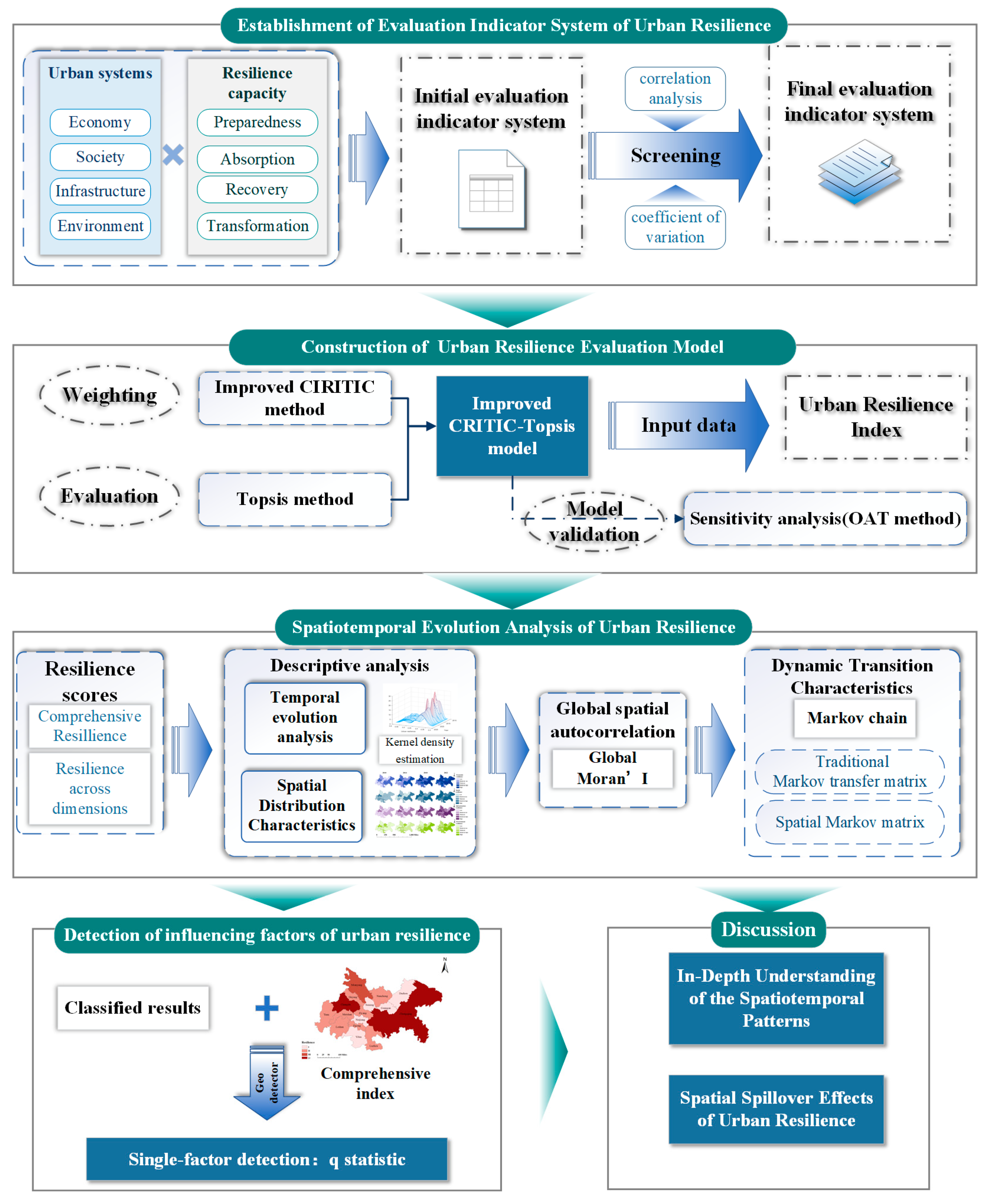


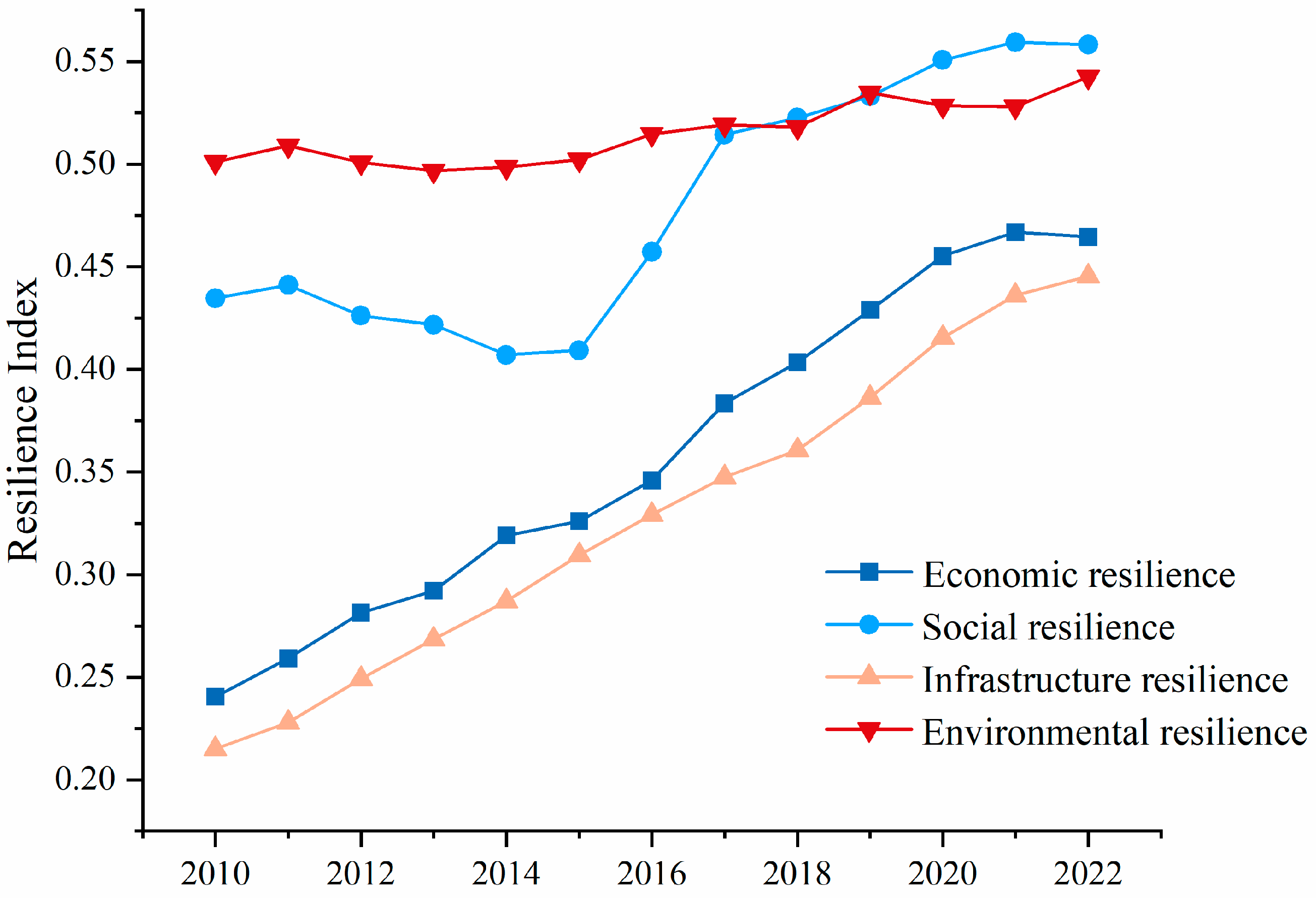
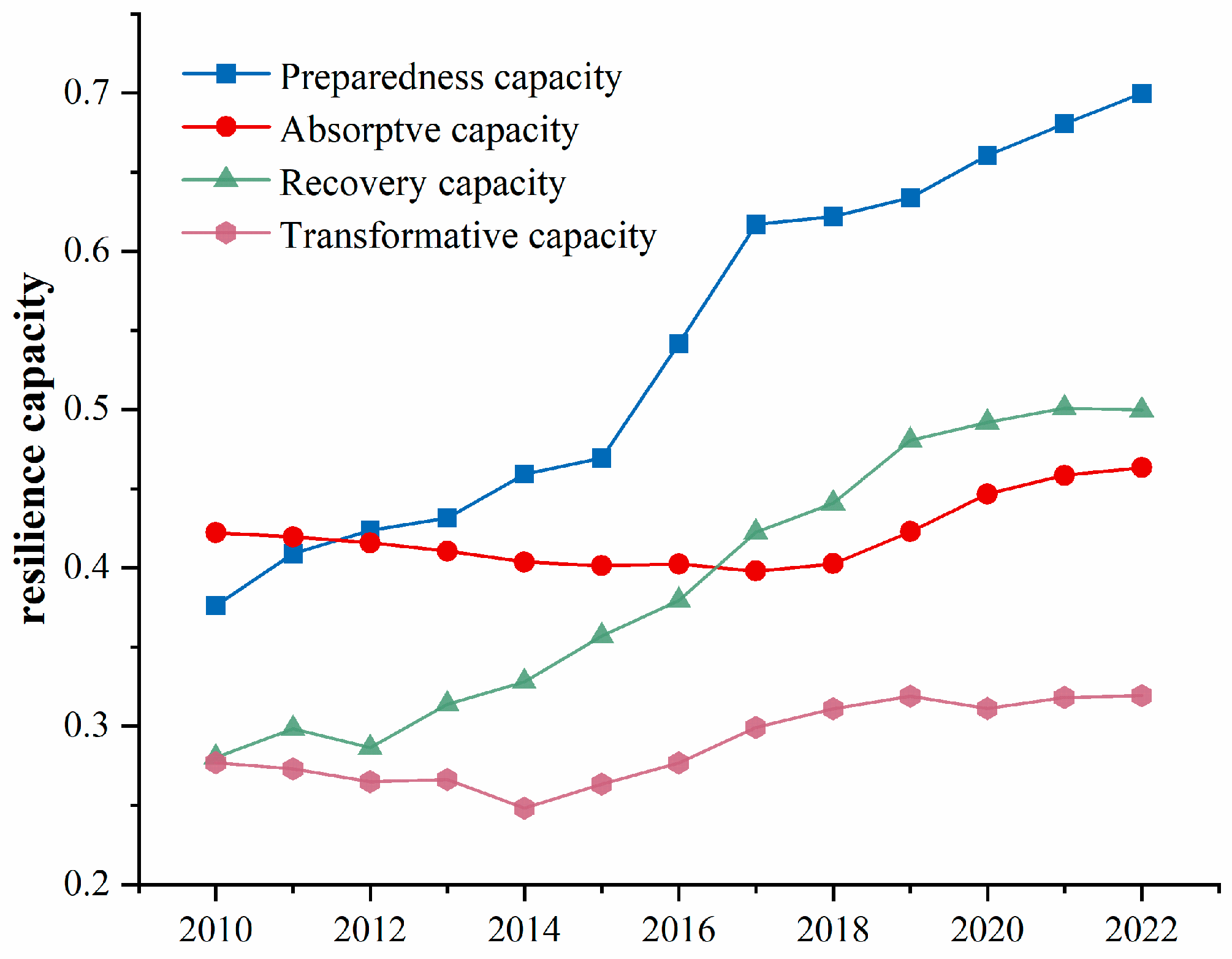
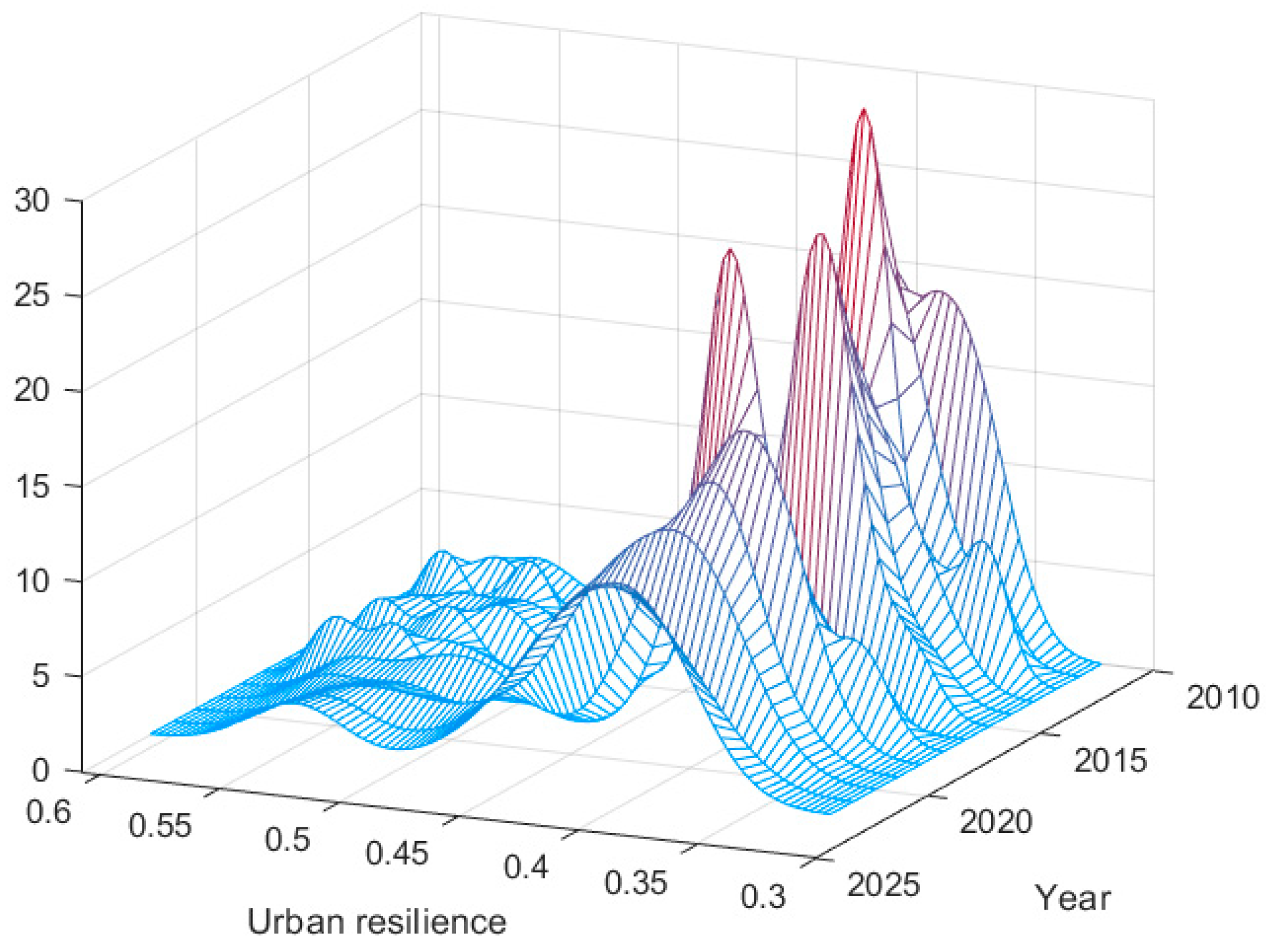

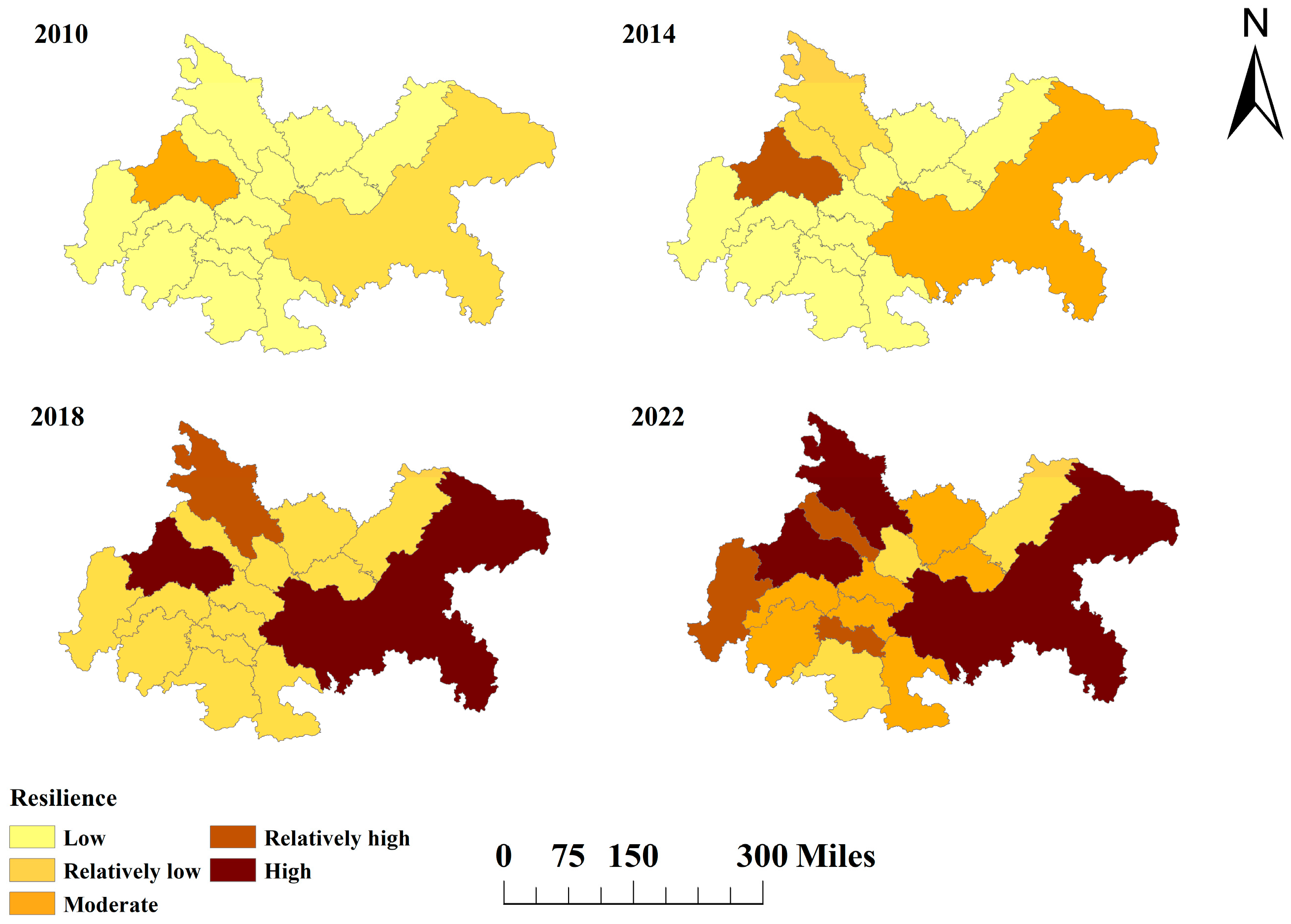
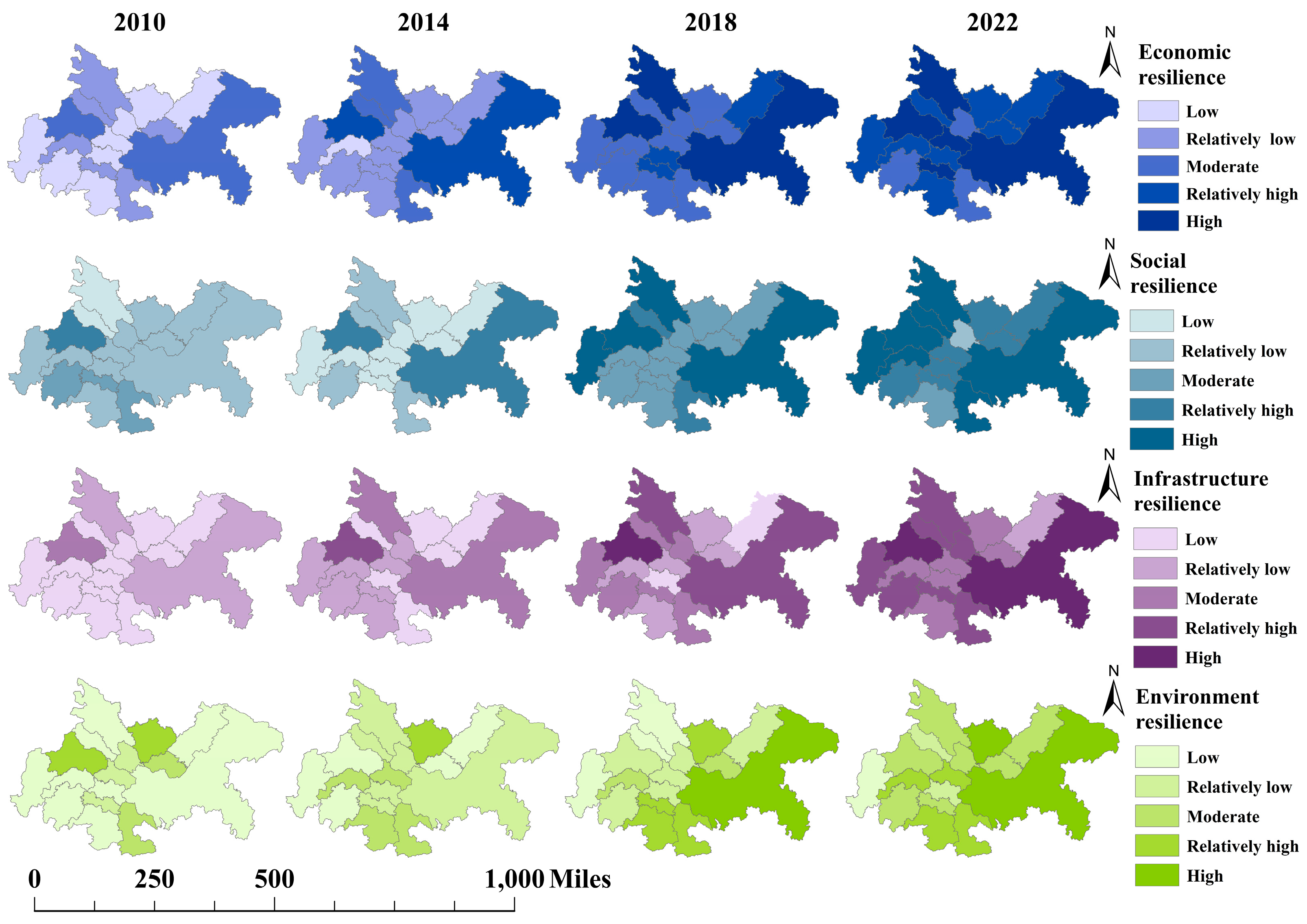
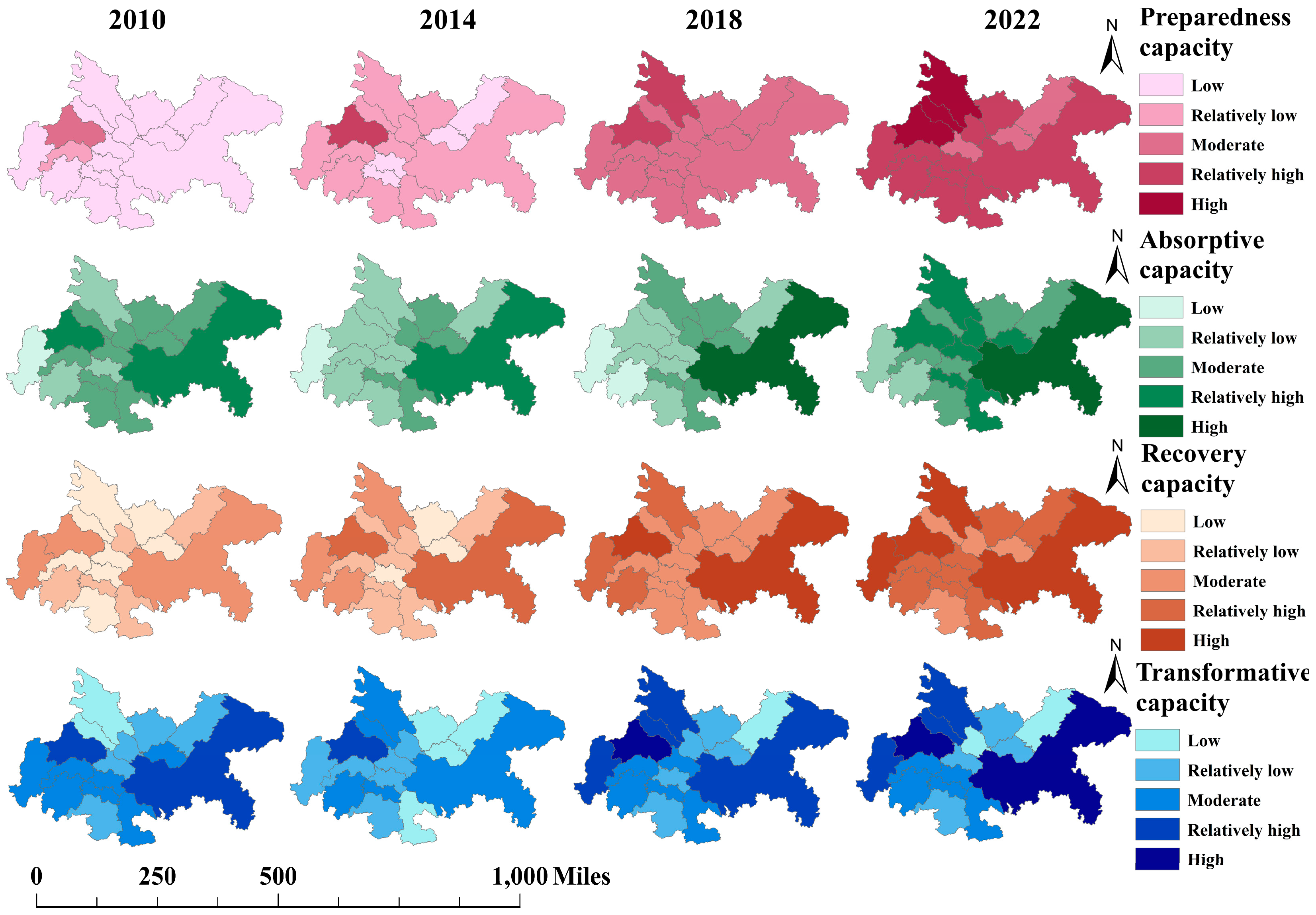
| Dimension | Indicators | Attribute | Unit | Resilience Capacity | References |
|---|---|---|---|---|---|
| Economic resilience | EC1 Economic tolerance | + | % | Preparedness capacity | [72,73] |
| EC2 Economic strength | + | CNY 100 million | Absorptive capacity | [74,75,76] | |
| EC3 Food security | + | Kg | Absorptive capacity | [77,78] | |
| EC4 Total retail sales of consumer goods | + | CNY 100 million | Recovery capacity | [79] | |
| EC5 Proportion of the tertiary industry | + | % | Recovery capacity | [80] | |
| EC6 Fiscal revenue | + | CNY 104 | Recovery capacity | [73,81] | |
| EC7 Technological investment | + | % | Transformative capacity | [75,79] | |
| Social resilience | SC1 Medical insurance coverage | + | % | Preparedness capacity | [52,82] |
| SC2 Proportion of vulnerable populations | − | % | Absorptive capacity | [83,84] | |
| SC3 Unemployment rate | − | % | Absorptive capacity | [18,57,76] | |
| SC4 Number of employees in public administration and social organizations | + | 104 persons | Absorptive capacity | [79,85] | |
| SC5 Social security and employment support | + | % | Recovery capacity | [75,85] | |
| SC6 Educational levels | + | persons | Transformative capacity | [86,87,88] | |
| SC7 Long-term public safety expenditures | + | % | Transformative capacity | [89] | |
| Infrastructure resilience | IN1 Drainage pipeline density | + | km/km2 | Preparedness capacity | [73,76,90] |
| IN2 Communication technology capacity | + | % | Preparedness capacity | [89,91,92] | |
| IN3 Per capita road area | + | m2 | Absorptive capacity | [79,93] | |
| IN4 Water supply pipeline density | + | km/km2 | Absorptive capacity | [73] | |
| IN5 Number of hospital beds per 1000 people. | + | pieces | Recovery capacity | [72,76] | |
| IN6 Public transportation availability | + | 104 passenger trips | Recovery capacity | [78,79] | |
| IN7 Urban infrastructure investment | + | CNY 104 | Transformative capacity | [92] | |
| Environment resilience | EN1 Long-term precipitation | − | mm | Preparedness capacity | [18,94,95] |
| EN2 Precipitation during the flood season | − | mm | Preparedness capacity | [74,76,89] | |
| EN3 Urban green coverage ratio | % | Absorptive capacity | [57,75,79] | ||
| EN4 Industrial pollution | − | t | Preparedness capacity | [79] | |
| EN5 Cultivated land area | + | h m2 | Absorptive capacity | [81,82,94] | |
| EN6 Terrain undulation | − | / | Absorptive capacity | [82,96] | |
| EN7 Forest coverage | + | % | Recovery capacity | [18,84,94] | |
| EN8 Environmental protection investment | + | % | Transformative capacity | [52] |
| Dimension | Index | Weight | Dimension | Index | Weight |
|---|---|---|---|---|---|
| Economic Resilience | EC1 | 5.390 | Social Resilience | SC1 | 5.395 |
| EC2 | 4.096 | SC2 | 5.365 | ||
| EC3 | 2.461 | SC3 | 4.446 | ||
| EC5 | 5.662 | SC5 | 2.937 | ||
| EC7 | 3.917 | SC6 | 5.403 | ||
| SC7 | 3.160 | ||||
| Infrastructure Resilience | IN1 | 2.947 | Environment Resilience | EN2 | 1.883 |
| IN2 | 6.244 | EN3 | 3.588 | ||
| IN3 | 4.127 | EN4 | 3.681 | ||
| IN4 | 3.399 | EN5 | 3.366 | ||
| IN5 | 5.586 | EN6 | 3.715 | ||
| IN6 | 3.700 | EN7 | 2.674 | ||
| IN7 | 4.839 | EN8 | 2.019 |
| Year | 2010 | 2011 | 2012 | 2013 | 2014 | 2015 | 2016 |
| Moran’s I | 0.0474 | 0.0800 | 0.1200 | 0.1261 | 0.1308 | 0.1521 | 0.0813 |
| Year | 2017 | 2018 | 2019 | 2020 | 2021 | 2022 | |
| Moran’s I | 0.1410 | 0.1007 | 0.0885 | 0.0905 | 0.1151 | 0.1063 |
| t/(t + 1) | Ⅰ | Ⅱ | Ⅲ | Ⅳ | Ⅴ | n |
|---|---|---|---|---|---|---|
| Ⅰ | 0.8391 | 0.1609 | 0.0000 | 0.0000 | 0.0000 | 87 |
| Ⅱ | 0.0000 | 0.6875 | 0.3125 | 0.0000 | 0.0000 | 48 |
| Ⅲ | 0.0000 | 0.0000 | 0.7241 | 0.2759 | 0.0000 | 29 |
| Ⅳ | 0.0000 | 0.0000 | 0.0556 | 0.7778 | 0.1667 | 18 |
| Ⅴ | 0.0000 | 0.0000 | 0.0000 | 0.1000 | 0.9000 | 10 |
| t/(t + 1) | I | II | III | IV | V | n | |
|---|---|---|---|---|---|---|---|
| I | I | 0.9107 | 0.0893 | 0.0000 | 0.0000 | 0.0000 | 56 |
| II | 0.0000 | 0.8000 | 0.2000 | 0.0000 | 0.0000 | 5 | |
| III | 0.0000 | 0.0000 | 0.6000 | 0.4000 | 0.0000 | 5 | |
| IV | 0.0000 | 0.0000 | 0.0000 | 0.6667 | 0.3333 | 6 | |
| V | 0.0000 | 0.0000 | 0.0000 | 0.0000 | 0.0000 | 0 | |
| II | I | 0.7586 | 0.2414 | 0.0000 | 0.0000 | 0.0000 | 29 |
| II | 0.0000 | 0.8125 | 0.1875 | 0.0000 | 0.0000 | 16 | |
| III | 0.0000 | 0.0000 | 0.3333 | 0.6667 | 0.0000 | 3 | |
| IV | 0.0000 | 0.0000 | 0.0000 | 0.5000 | 0.5000 | 2 | |
| V | 0.0000 | 0.0000 | 0.0000 | 0.2000 | 0.8000 | 5 | |
| III | I | 0.0000 | 1.0000 | 0.0000 | 0.0000 | 0.0000 | 2 |
| II | 0.0000 | 0.6364 | 0.3636 | 0.0000 | 0.0000 | 22 | |
| III | 0.0000 | 0.0000 | 1.0000 | 0.0000 | 0.0000 | 10 | |
| IV | 0.0000 | 0.0000 | 0.0000 | 1.0000 | 0.0000 | 5 | |
| V | 0.0000 | 0.0000 | 0.0000 | 0.0000 | 1.0000 | 4 | |
| IV | I | 0.0000 | 0.0000 | 0.0000 | 0.0000 | 0.0000 | 0 |
| II | 0.0000 | 0.4000 | 0.6000 | 0.0000 | 0.0000 | 5 | |
| III | 0.0000 | 0.0000 | 0.6364 | 0.3636 | 0.0000 | 11 | |
| IV | 0.0000 | 0.0000 | 0.2000 | 0.8000 | 0.0000 | 5 | |
| V | 0.0000 | 0.0000 | 0.0000 | 0.0000 | 1.0000 | 1 | |
| V | I | 0.0000 | 0.0000 | 0.0000 | 0.0000 | 0.0000 | 0 |
| II | 0.0000 | 0.0000 | 0.0000 | 0.0000 | 0.0000 | 0 | |
| III | 0.0000 | 0.0000 | 0.0000 | 0.0000 | 0.0000 | 0 | |
| IV | 0.0000 | 0.0000 | 0.0000 | 0.0000 | 0.0000 | 0 | |
| V | 0.0000 | 0.0000 | 0.0000 | 0.0000 | 0.0000 | 0 |
| Dimensions | Index | q Statistic | AVE | |||
|---|---|---|---|---|---|---|
| 2010 | 2014 | 2018 | 2022 | |||
| Preparedness capacity | EC1 Economic tolerance | 0.177 | 0.211 | 0.826 | 0.193 | 0.207 |
| SC1 Medical insurance coverage | 0.826 | 0.909 | 0.165 | 0.383 | 0.571 | |
| IN2 Communication technology capacity | 0.814 | 0.628 | 0.686 | 0.607 | 0.684 | |
| IN1 Drainage pipeline density | 0.816 | 0.235 | 0.200 | 0.457 | 0.427 | |
| EN2 Precipitation during the flood season | 0.139 | 0.229 | 0.268 | 0.261 | 0.224 | |
| EN4 Industrial pollution | 0.176 | 0.393 | 0.562 | 0.508 | 0.410 | |
| Absorptive capacity | EC2 Economic strength | 0.744 | 0.888 | 0.480 | 0.800 | 0.797 |
| EC3 Food security | 0.305 | 0.300 | 0.966 | 0.401 | 0.338 | |
| SC2 Proportion of vulnerable populations | 0.784 | 0.735 | 0.460 | 0.540 | 0.630 | |
| SC3 Unemployment rate | 0.799 | 0.378 | 0.705 | 0.460 | 0.585 | |
| IN3 Per capita road area | 0.284 | 0.283 | 0.145 | 0.169 | 0.220 | |
| IN4 Water supply pipeline density | 0.342 | 0.113 | 0.644 | 0.285 | 0.346 | |
| EN5 Cultivated land area | 0.302 | 0.453 | 0.483 | 0.508 | 0.437 | |
| EN6 Terrain undulation | 0.203 | 0.339 | 0.345 | 0.338 | 0.306 | |
| EN3 Urban green coverage ratio | 0.818 | 0.165 | 0.300 | 0.229 | 0.378 | |
| Recovery capacity | EC5 Proportion of the tertiary industry | 0.716 | 0.925 | 0.448 | 0.436 | 0.705 |
| SC5 Social security and employment support | 0.160 | 0.199 | 0.731 | 0.525 | 0.404 | |
| IN5 Number of hospital beds per 1000 people. | 0.250 | 0.323 | 0.726 | 0.201 | 0.375 | |
| IN6 Public transportation availability | 0.709 | 0.907 | 0.734 | 0.791 | 0.785 | |
| EN7 Public transportation availability | 0.268 | 0.064 | 0.092 | 0.193 | 0.154 | |
| Transformative capacity | EC7 Technological investment | 0.859 | 0.335 | 0.285 | 0.802 | 0.690 |
| SC6 Educational levels | 0.775 | 0.728 | 0.650 | 0.682 | 0.709 | |
| SC7 Long-term public safety expenditures | 0.324 | 0.364 | 0.447 | 0.304 | 0.360 | |
| IN7 Long-term public safety expenditures | 0.873 | 0.872 | 0.842 | 0.854 | 0.860 | |
| EN8 Environmental protection investment | 0.291 | 0.366 | 0.117 | 0.117 | 0.223 | |
Disclaimer/Publisher’s Note: The statements, opinions and data contained in all publications are solely those of the individual author(s) and contributor(s) and not of MDPI and/or the editor(s). MDPI and/or the editor(s) disclaim responsibility for any injury to people or property resulting from any ideas, methods, instructions or products referred to in the content. |
© 2025 by the authors. Licensee MDPI, Basel, Switzerland. This article is an open access article distributed under the terms and conditions of the Creative Commons Attribution (CC BY) license (https://creativecommons.org/licenses/by/4.0/).
Share and Cite
Zhang, R.; Zhou, J.; Sun, F.; Xu, H.; Xing, H. Spatiotemporal Evolution and Driving Factors of Urban Resilience Against Disasters: A Dual Perspective of Urban Systems and Resilience Capacities. Land 2025, 14, 741. https://doi.org/10.3390/land14040741
Zhang R, Zhou J, Sun F, Xu H, Xing H. Spatiotemporal Evolution and Driving Factors of Urban Resilience Against Disasters: A Dual Perspective of Urban Systems and Resilience Capacities. Land. 2025; 14(4):741. https://doi.org/10.3390/land14040741
Chicago/Turabian StyleZhang, Ruoyi, Jiawen Zhou, Fei Sun, Hanyu Xu, and Huige Xing. 2025. "Spatiotemporal Evolution and Driving Factors of Urban Resilience Against Disasters: A Dual Perspective of Urban Systems and Resilience Capacities" Land 14, no. 4: 741. https://doi.org/10.3390/land14040741
APA StyleZhang, R., Zhou, J., Sun, F., Xu, H., & Xing, H. (2025). Spatiotemporal Evolution and Driving Factors of Urban Resilience Against Disasters: A Dual Perspective of Urban Systems and Resilience Capacities. Land, 14(4), 741. https://doi.org/10.3390/land14040741







